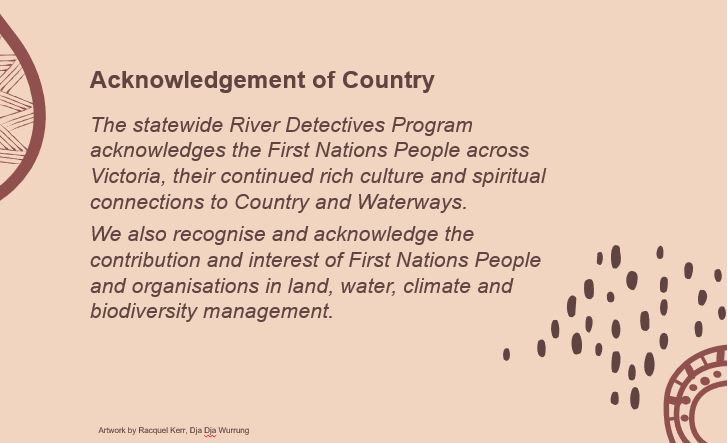Poster
Waterbug lifecycle posters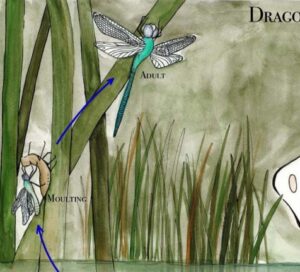
These gorgeous lifecycle illustrations have been drawn by Kahlea Spiby, a 19yr old Wurundjeri Woi Wurrung woman living on Yorta Yorta Country. Kahlea has a background in Conservation and Ecosystem Management and was engaged by the River Detectives program after participating in a Youth Takeover program. Many waterbugs spend part of their life in the water then morph into an adult and become an important flying insect in the broader ecosystem. These posters showing the lifecycles of the Caddisfly, Damselfly, Dragonfly, Stonefly and Mosquito will help you explore these species more intimately.
|
Sustainable Farms – enhancing dams resources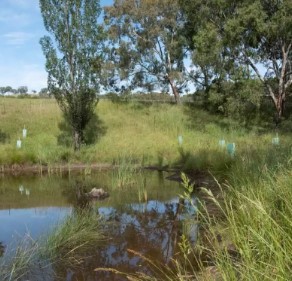
Dams are well-known features of farming landscapes. They are also valuable natural assets. ANU’s Sustainable Farms project works with farmers, land managers, NRM agencies, industry groups and Landcare towards a common goal: healthy farms, healthy farmers and healthy profits. They offer a range of great resources: a farm dam poster, life in a farm dam activity sheet, the Enhancing Farm Dams guide and the farm dam planting guide. For some great videos watch: Improving farm dams – a farmer’s perspective, life in a farm dam – after fire comes recovery and building a wildlife island on a farm dam. If constructing or renovating a dam, for the farm dams technical guide click here.
|
Wanyarram Dhelk Bendigo Creek site signage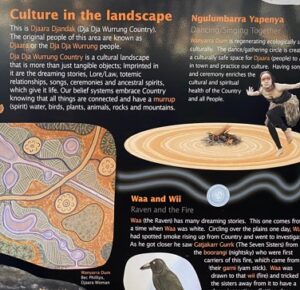
The gorgeous interpretive signs on site at Bendigo Creek’s Wanyarram Dhelk site near Knight St White Hills are a wealth of information about the cultural significance of waterways, caring for country (djandak) and water (gatjin). A visit to the site is a must do for schools in the Bendigo area. Learn more about the site by watching this video.
|
Waterbug ID sheet with larvae/adult comparison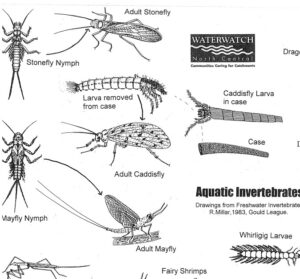
This resource is an ‘oldie but a goodie’ – useful because it shows a comparison between the nymph/larvae and adult forms of stonefly, mayfly, dragonfly, damselfly and caddisfly. Add it to your waterbug ID resources !
|
A to Z Creature Feature poster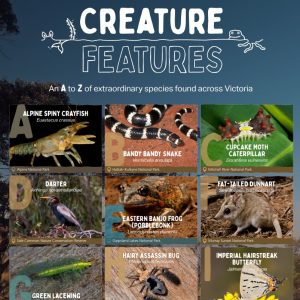
From the Alpine Spiny Crayfish to the Zebrafish, Parks Victoria’s A-Z poster will help students learn about some of Victoria’s weird and wonderful plants and animals. For more information about the places where they are found head to the Parks Victoria website.
|
The Water Cycle poster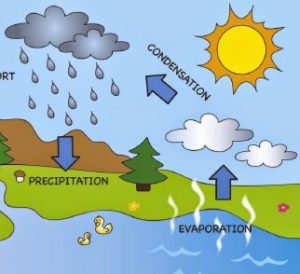
Use this poster when introducting/discussing the water cycle with students.
|
Seasonal Calendars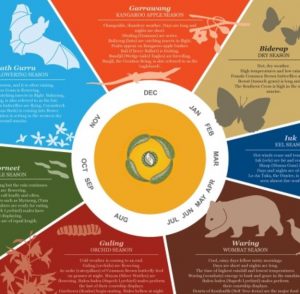
Aboriginal people traditionally lived by seasonal calendars not dictated by the conventions of summer, autumn, winter and spring but by the changes they observed in nature throughout a year. This is one example of a Kulin Nation seasonal calendar. You might be able to source one that is more specific to the traditional owners of your area ? Click here for an outline of the Wotjobaluk seasonal calendar for the Wimmera-Mallee area or view another version at the Visit Grampians website. Click here to watch a video about Dja Dja Wurrung seasons. Keep observations of your waterway and local catchment throughout a year with your students and make your own text or pictorial calendar inspired by a traditional seasonal version or this riparian/agricultural example from the North Central CMA. . . . .or combine the two !
|
Backyard Birds of Victoria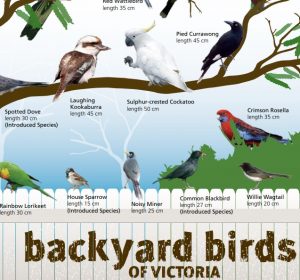
This great resource can be used as a identification chart for students to begin their birdwatching adventures and the second page is an excellent fact sheet with tips on bringing back birdlife to our parks, homes and gardens.
|
Wetland Illustration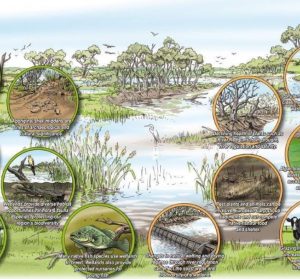
This illustration can be printed at A3 size to outline the important values of wetlands and highlight the factors that threaten their health.
|
Environmental Water in Northern Victoria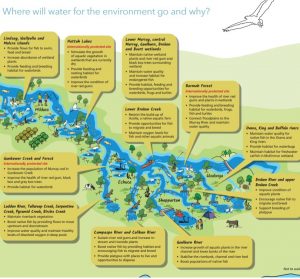
Many of Victoria’s rivers and wetlands have been modified to provide water vital for farms, homes and industry. Water for the environment also benefits communities by improving conditions for fishing, camping and canoeing. Improved water quality can have economic benefits for irrigation and urban water supply. This map shows how water for the environment will help improve and protect plants and animals in northern Victoria in 2020-21.
|
Richardson River’s Journey posters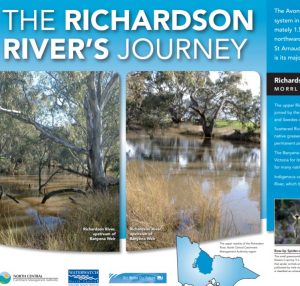
These two posters are an excellent resource for staff and students to familiarise themselves with the Richardson River – it’s; source, path, reaches, catchment, major towns, history, most notable features, flora, fauna and users. The engaging format, stunning photos and user-friendly text makes it the perfect tool for teacher background, student-lead research and learning about an important waterway in the north central region.
|
Re-snagging posters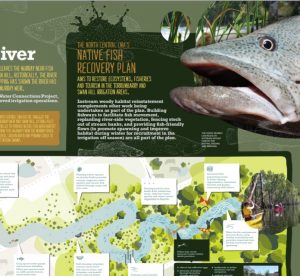
These two posters are invaluable to explain the importance of in-stream woody habitat to native fish and explains some of the important work that is taking place in the lower Loddon River and the Little Murray River as part of the north central CMA’s native fish recovery plan. Features include great photos, fact files, information and an excellent diagram outlining the threats and values in a waterway that impact on fish health.
|
Coliban River’s Journey poster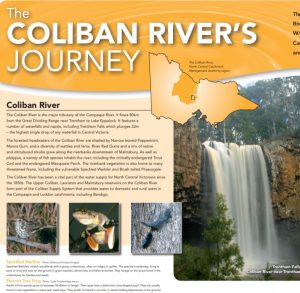
This poster is an excellent resource for staff and students to familiarise themselves with the Coliban River – it’s; source, path, catchment, major towns, history, most notable features, flora, fauna and users. The engaging format, stunning photos and user-friendly text makes it the perfect tool for teacher background, student-lead research and learning about an important waterway in the north central region.
|
Water Birds of the Loddon River poster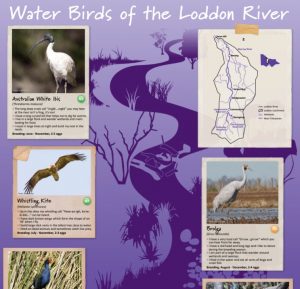
This is a wonderful poster showcasing six of the most important native water bird species of the Loddon River. It features a map of the Loddon River and its catchment and fact files on six water bird species outlining; appearance, size, life cycle, habitat, diet, breeding, behaviour, calls and conservation status. Use the Natureblitz App to listen to calls and record sightings.
|
Frogs of the Loddon River poster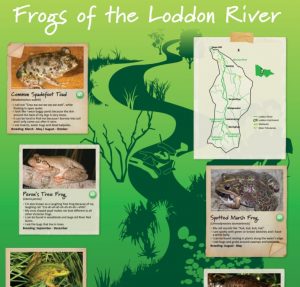
This is a wonderful poster showcasing six of the most important native frog species of the Loddon River. It features a map of the Loddon River and its catchment and fact files on six frog species outlining; appearance, size, life cycle, habitat, diet, breeding, behaviour, calls and conservation status. Use the Natureblitz App to listen to frog calls and record sightings.
|
Fish of the Loddon River poster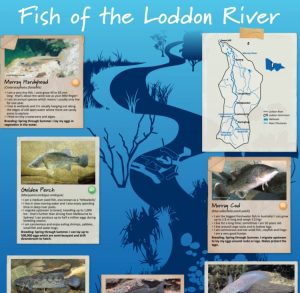
This is a wonderful poster showcasing six of the most important native fish species of the Loddon River. It features a map of the Loddon River and its catchment and fact files on six fish species outlining; appearance, size, life cycle, habitat, diet, breeding, behaviour and conservation status. Use the Natureblitz App to record sightings.
|
Avoca River’s Journey posters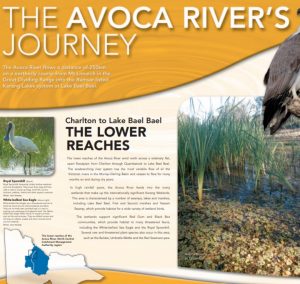
These three posters are an excellent resource for staff and students to familiarise themselves with the Avoca River – it’s; source, path, reaches, catchment, major towns, history, most notable features, flora, fauna and users. The engaging format, stunning photos and user-friendly text makes it the perfect tool for teacher background, student-lead research and learning about an important waterway in the north central region.
|
Loddon River’s Journey posters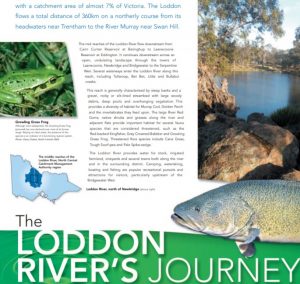
These three posters are an excellent resource for staff and students to familiarise themselves with the Loddon River – it’s; source, path, reaches, catchment, major towns, history, most notable features, flora, fauna and users. The engaging format, stunning photos and user-friendly text makes it the perfect tool for teacher background, student-lead research and learning about an important waterway in the north central region.
|
Campaspe River’s Journey posters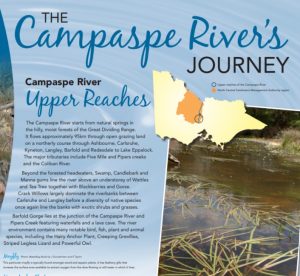
These two posters are an excellent resource for staff and students to familiarise themselves with the Campaspe River – it’s; source, path, reaches, catchment, major towns, most notable features, flora, fauna and users. The engaging format, stunning photos and user-friendly text makes it the perfect tool for teacher background, student-lead research and learning about an important waterway in the north central region.
|
Fish Need Trees poster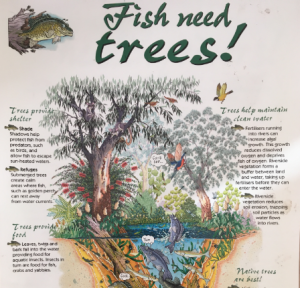
This beautiful graphic illustrates the variety of ways that fish use trees in and beside waterways and why it’s essential we retain and replace them.
|
Fish Need Healthy Rivers poster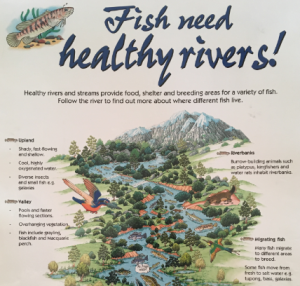
This is a great poster highlighting the features of waterways that fish require for food, shelter, breeding and migration, from source to mouth.
|
Water Quality Rating Charts
Numbers are just numbers until you work out what they mean. Use the regional water quality rating chart from the Field Manual in your kit to compare your data for EC, turbidity, reactive phosphorus and pH to assess the health of your waterway. Or use the links below to print an enlarged copy for student use; Corangamite CMA, Melbourne Water, North East CMA, North Central CMA, Wimmera CMA
|
Urban Stormwater poster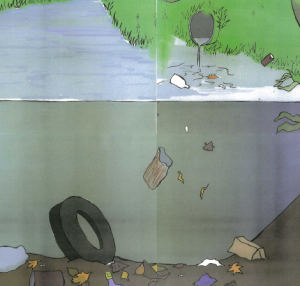
This poster is a fantastic resource to use demonstrate the impact of litter that can flow into a waterway with urban stormwater. It highlights the often unknown fact that only 10% of waterway litter is visible from the surface and a disturbing 90% will be hidden under the water. The Water Bug pictures could be placed on the poster to create discussion about how they (and other fauna) would be impacted by stormwater pollution and how this would impact on the entire food chain.
|
Salinity Solutions poster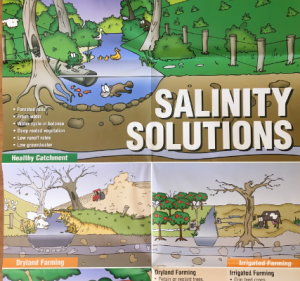
Print this coloured poster at A4 or A3 size for a great visual aid to discuss the features of a healthy catchment and the strategies to reduce salinity in dryland farming, irrigated farming and urban areas.
|
In-Stream Habitat Poster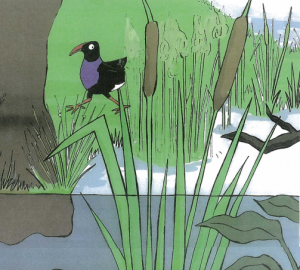
This poster is a fantastic resource to use during macroinvertebrate sampling sessions to demonstrate the five habitats that exist within a waterway; on the surface (surface zone), in open water (deep zone), amongst vegetation (reed zone), on rocks/logs/gravel (substrate zone) and amid the sediment (benthic zone). Use the links below to each quarter of the poster to print as A3, laminate and join for a class-size poster you can keep. Top left, top right, bottom left, bottom right Use the information on the reverse of the Waterbug Cards to have students place them in their correct habitat on the poster.
|
The Loddon River Seasonal Calendar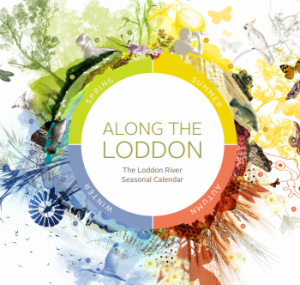
This beautiful poster can be used for inspiration to make a similar resource for a year in the life of your own waterway. Use words and pictures to document seasonal changes in weather, fauna, flora, water, land, agriculture and community life.
|
Riparian Zone Poster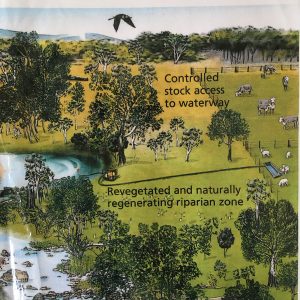
An excellent graphic to highlight the key features of a healthy riparian zone compared to a degraded riparian zone. Great for conversations about water quality, habitat health, land practices and shared community responsibility for the health of our waterways.
|
Water Quality Results Posters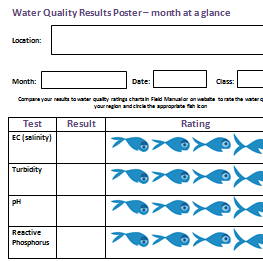
Use these posters to record and display your monthly or yearly results at a glance. Share them with others by printing in the school / community newsletter or displaying them in the classroom, school foyer or even a local shop or community meeting place.
|
pH Scale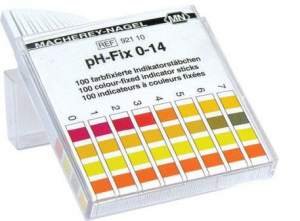
This graphic is the perfect tool to introduce pH, explain acidity and alkalinity to students and compare your pH reading to everyday household items.
|
Salinity Scale
Use this resource to check the salinity tolerances of humans, crops, livestock, compare your EC results and understand how salinity can impact on all areas of life.
|
Waterbugs Higher Level Key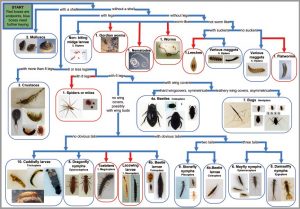
Closely observe the features of macroinvertebrates and use the questions on this key to work your way to an identification using the Agreed Level Taxonomy (ALT) method. For more info on ALT method, go to: thewaterbug.net
|
Waterbug ID chartUse this poster as a field guide to identify waterbugs in your sample, understand the in-stream habitats they prefer and use the sensitivity scores to rate the health of your waterway. It can be laminated (or similar) and used with white board markers for longevity.
|
Salinity in our waterways poster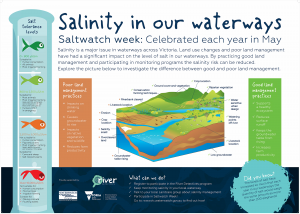
Use this poster to explore the issue of salinity and examine positive and negative land management practices that contribute to the issue.
|
Our platypus – information brochure (posters)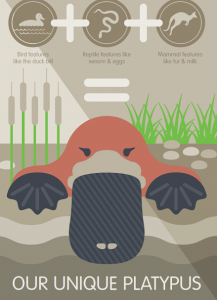
This brochure developed by Melbourne Water is useful for any region with great information presented in a very clear format that could be used as posters for the classroom.
|

